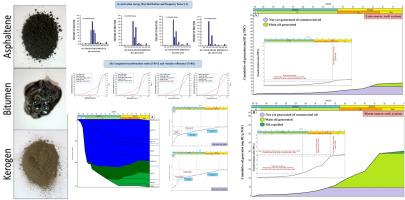也门东南部Shabwah凹陷页岩油潜力:地球化学和盆地模拟视角
IF 2.2
4区 地球科学
Q2 GEOSCIENCES, MULTIDISCIPLINARY
引用次数: 0
摘要
通过对Shabwah坳陷上侏罗统Madbi组Lam和Meem富有机质页岩相进行多尺度地球化学、岩石学和矿物学研究,以及整体动力学和盆地建模分析,以了解非常规油页岩储层潜力。页岩中有机质含量显著,总有机碳(TOC)含量在1% ~ 12.3%之间。Lam和Meem页岩相还具有富氢干酪根II型和富氢干酪根II/III型特征。通过对干酪根组分的Py-GC和FTIR结构分析,证实了这种富氢干酪根的优势,表明了生产低蜡含量石蜡环芳烃油的可能性。从镜质体反射率(VRo)和高含油饱和度指数(OSI)的测量结果来看,所研究的页岩相目前已经热成熟,Meem页岩相进入了油窗的峰值阶段。这一结论与整体动力学结果一致,表明在132°C至155°C的地质温度范围内,在油窗的峰值阶段,高达50%的干酪根转化可以产生商业量的石油,与计算的镜质组反射率值0.77 - 1.07% Ro一致。1-D盆地模拟表明,Meem页岩烃源岩体系比Lam页岩烃源岩多,在下白垩世至晚渐新世进入主力生油期,形成商业油量,转化比(TR)高达55%。这种高的最大生油量,加上高脆性指数,导致在Meem页岩相中形成非组构裂缝孔隙,这可能是由于深埋时压力升高而增加的。因此,非常规页岩油储层应考虑Meem页岩相,并推荐非常规生产水力压裂技术。本文章由计算机程序翻译,如有差异,请以英文原文为准。

Shale–oil potential in Shabwah depression, southeast Yemen: A geochemical and basin modeling perspective
The Lam and Meem organic-rich shale facies of the Upper Jurassic Madbi Formation in the Shabwah Depression are subjected to multi-scale geochemical, petrographical and mineralogical investigation, alongside bulk kinetics and basin modeling analyses for understanding the unconventional oil shale reservoir potential. The studied shales exhibit significant organic matter, with total organic carbon (TOC) between 1 wt % and 12.3 wt %. The Lam and Meem shale facies are also charactersied by hydrogen rich kerogen types II and II/III. The dominance of such hydrogen-rich kerogen was confirmed from the Py-GC and FTIR structures of the kerogen fraction, exhibiting the possibility of producing commercial amounts of paraffinic–naphthenic–aromatic oils with low wax content. The studied shale facies is currently thermally mature, with the Meem shale facies entered the peak-stage of the oil window, based on measured vitrinite reflectance (VRo) values and high oil saturation index (OSI) values. This claim agrees with the bulk kinetic results, which suggest that the commercial amounts of oil can generate by kerogen conversion of up to 50 % during the peak stage of oil window at geological temperature values between 132 °C and 155 °C, consistent with computed vitrinite reflectance values of 0.77–1.07 %Ro. 1-D basin modeling suggests the Meem shale source rock system is more than the Lam shale source rock, entering the main oil generation during the lower Cretaceous to Late Oligocene time, resulting in commercial quantities of oil, having transformation ratio (TR) i.e. up to 55 %. This high maximum oil generation, alongside high brittleness index leads to create non-fabric fracture pores within the Meem shale facies, which may have increased by elevated pressure during the deep burial depths. Therefore, the Meem shale facies is considered for unconventional shale oil reservoir with recommendation of hydraulic fracturing techniques for unconventional production.
求助全文
通过发布文献求助,成功后即可免费获取论文全文。
去求助
来源期刊

Journal of African Earth Sciences
地学-地球科学综合
CiteScore
4.70
自引率
4.30%
发文量
240
审稿时长
12 months
期刊介绍:
The Journal of African Earth Sciences sees itself as the prime geological journal for all aspects of the Earth Sciences about the African plate. Papers dealing with peripheral areas are welcome if they demonstrate a tight link with Africa.
The Journal publishes high quality, peer-reviewed scientific papers. It is devoted primarily to research papers but short communications relating to new developments of broad interest, reviews and book reviews will also be considered. Papers must have international appeal and should present work of more regional than local significance and dealing with well identified and justified scientific questions. Specialised technical papers, analytical or exploration reports must be avoided. Papers on applied geology should preferably be linked to such core disciplines and must be addressed to a more general geoscientific audience.
 求助内容:
求助内容: 应助结果提醒方式:
应助结果提醒方式:


